Zoom
Trash
Related: bioplastic, mycelium, komboecha
- architecture
- Space and Astronomy
- Education
- Enterprise

Sugar-Producing Bacteria To Be Tested in Space as Food Source for Astronauts. The Key to Colonizing Mars Could Be These Tiny Green Microbes.
Let's Nuke Mars! Astromike23 comments on How would nuking Mars' poles create greenhouse gases? Terraforming Mars by nudging asteroids into a collision course, forty such impacts would give Mars a temperate climate, and enough water would have been melted to cover a quarter of the planet with a layer of water 1m deep. : space. Theconversation. Gravity is a constant for all organisms on Earth.
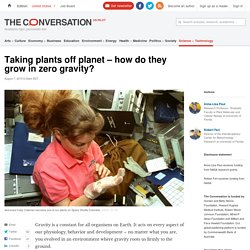
It acts on every aspect of our physiology, behavior and development – no matter what you are, you evolved in an environment where gravity roots us firmly to the ground. But what happens if you’re removed from that familiar environment and placed into a situation outside your evolutionary experience? That’s exactly the question we ask every day of the plants we grow in our laboratory.
Mars One Is Still Completely Full of Shit. DARPA: We Are Engineering the Organisms That Will Terraform Mars. Terraformed Mars, artist's conception.
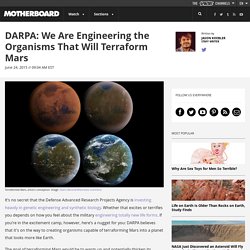
Image: Daein Ballard/Wikimedia Commons It’s no secret that the Defense Advanced Research Projects Agency is investing heavily in genetic engineering and synthetic biology. Whether that excites or terrifies you depends on how you feel about the military engineering totally new life forms. If you’re in the excitement camp, however, here’s a nugget for you: DARPA believes that it's on the way to creating organisms capable of terraforming Mars into a planet that looks more like Earth.
The goal of terraforming Mars would be to warm up and potentially thicken its atmosphere by growing green, photosynthesizing plants, bacteria, and algae on the barren Martian surface. NASA Wants Your Help Figuring Out How to Build Space Habitats. NASA Will Make Oxygen From CO2 On the Surface of Mars. How Asteroid Mining Could Pay for Our First Space Colony.
A Warm Seafloor On Enceladus Makes It A Prime Candidate For Life. Saturn's Moon Enceladus Has a Warm Ocean, Could Have Life. Move over, Europa.
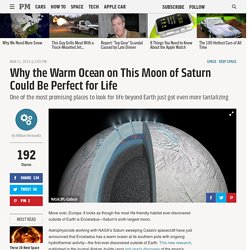
It looks as though the most life-friendly habitat ever discovered outside of Earth is Enceladus—Saturn's sixth-largest moon. Astrophysicists working with NASA's Saturn sweeping Cassini spacecraft have just announced that Enceladus has a warm ocean at its southern pole with ongoing hydrothermal activity—the first ever discovered outside of Earth. This new research, published in the journal Nature, builds upon last year's discovery of the moon's 6-mile-deep ocean, which is also believed to contain many of the chemicals commonly associated with life. "We now have very strong evidence that there is a hot hydrothermal environment at the base of Enceladus's ocean, perhaps like those where we believe life began on Earth," says Jonathan Lunine, a planetary scientist at Cornell University who works with the Cassini spacecraft but was not involved in the new research.
Terraforming the Solar System. The Surprisingly Strong Case for Colonizing Venus. Why worry about building a colony on Mars when instead you could float one high above the surface of Venus?
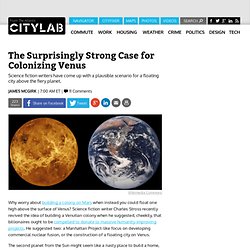
Science fiction writer Charles Stross recently revived the idea of building a Venutian colony when he suggested, cheekily, that billionaires ought to be compelled to donate to massive humanity-improving projects. He suggested two: a Manhattan Project-like focus on developing commercial nuclear fusion, or the construction of a floating city on Venus. The second planet from the Sun might seem like a nasty place to build a home, with a surface temperature hot enough to melt lead and an atmosphere so dense it would feel like being submerged beneath 3000 feet of water.
But the air on Venus thins out as you rise above the surface and cools considerably; about 30 miles up you hit the sweet spot for human habitation: Mediterranean temperatures and sea-level barometric pressure. If ever there were a place to build a floating city, this would be it. Atmospheric pressure is also crucial. Selenian Boondocks » Venus. Space Station research shows that hardy little space travelers could colonize Mars.
2-May-2014 [ Print | E-mail ] Share [ Close Window ] Contact: Laura NilesLaura.E.Niles@nasa.gov 281-244-7069NASA/Johnson Space Center In the movies, humans often fear invaders from Mars.
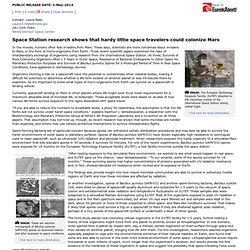
These days, scientists are more concerned about invaders to Mars, in the form of micro-organisms from Earth. Organisms hitching a ride on a spacecraft have the potential to contaminate other celestial bodies, making it difficult for scientists to determine whether a life form existed on another planet or was introduced there by explorers. Currently, spacecraft landing on Mars or other planets where life might exist must meet requirements for a maximum allowable level of microbial life, or bioburden.
"If you are able to reduce the numbers to acceptable levels, a proxy for cleanliness, the assumption is that the life forms will not survive under harsh space conditions," explains Kasthuri J. . [ Print | E-mail Share ] [ Close Window ] AAAS and EurekAlert! The One Scientific Field Most Likely to Get Humanity Into Space. '2312', by KS Robinson, is the first, best example of the ways in which speculative fiction serves to imagine first, a solar ecology - replete with diverse microecologies - through terraforming.
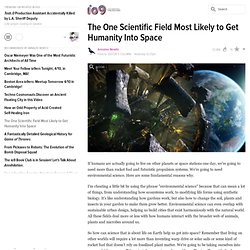
In fact, Terraforming and remedial Terraforming might be the most appropriate name for your speculative, synergistic, scientific field. In my view. It also can be instrumental in shifting humanity's sense of time from immediate gratification, to an intermediate, historical sense of future achievement - the timeframes necessary for moving into the cosmos - even at the local scale - will need to be attenuated and adjusted accordingly on a social-psychological scale. And while I'm here, may I appeal to the editors to begin crediting images regularly again?
- sometime in the recent past this fell off the grid of givens. The Complications of Sex in Space. Credit: Misha Gravenor Among the most basic needs – not to mention, desires – that human beings must contend with is the very complicated task of reproduction.

The complexities and pleasures of this instinctual act are as beautiful as they are important. It, like most “normal” tasks, becomes much more difficult once you fly beyond the thin band that separates Earth from the heavens. So, what’s the big deal, you may ask? Sex in Space: First, both NASA and the Russian Federal Space Agency officially claim that the act of sexual penetration has never occurred in space, but (as always) there are rumors and innuendos that indicate otherwise. Behold the incredible places where we'll build cities in space. Another thought provoking article at io9.

Europa is a must-go-now destination. Forget about the very entertaining film of the same name, I want to see a global effort to send a submersible probe, outfitted with a drill to find passage beneath it's icy surface, and I don't want to wait twenty years for this to happen. The exploration, militarization and colonization of our solar systems jurisdiction is "crucial" to the survival of our species. Table_of_Contents1.html. Right now, people are living in a Mars colony — here's what it looks like. The 2 Secrets to Sending People to Mars.